Mostly Pleasant Garden Surprises
The deer decided to make their 2024 appearance in the garden last night and proceeded to munch away at several of my perennials. I always blame deer for the carnage, but it could have been rabbits. My plumbago and geraniums in the waterfall garden have been gnawed to the stems, but the good news is both plants are summer bloomers and have plenty of time to grow back. Note: Readers should reference a post published Feb. 16 and saved in the archive called, “It Will Grow Back.” That I’ve written these words must mean that I’m maturing as an experienced gardener….right? Like every other time the deer have their dinner in the garden, I’m depressed. My poor geraniums.
Considering the situation, I’ve decided to focus this letter on recent pleasant surprises in the garden. There are several plants that have shocked me either by being alive, a low bar if there ever was one, or by looking like they are going to bloom for the first time, which is another very exciting event in the life of a Type A Gardener who too often gives up on his plants. Here are three stories that might entertain you this spring. And they may even help to cheer me up.
If you look through garden photos going back over the past few seasons, and you dare to look at pictures of the left side of the steps bed heading up to the driveway, you will see photos of generations of perennials that just didn’t make it. The latest is hardy begonia, a perennial that thrives in shade and just about any kind of soil. This plant was a nominee for the Ken Solow 2023 “Best New Plant” award as three of them were replacements for hardy begonias that had died the previous year. Of course, the good news wouldn’t last. The begonia plants were doing well until we had the tree guys come in to trim our poplar tree last fall. While pulling massive tree limbs up the steps to the woodchipper, they ruined many of the plants located around the steps, including the begonias. I completely forgot about the begonias this year, except for some reason, I left the little plastic plant tag from the nursery stuck in the ground. Imagine my surprise when several weeks ago, what I assumed to be a begonia plant poked its head above ground right next to the tag. A quick check on PictureThis confirmed that it is, indeed, a hardy begonia. So far, it shows no sign of disappointing as it keeps growing. A very pleasant surprise number one.
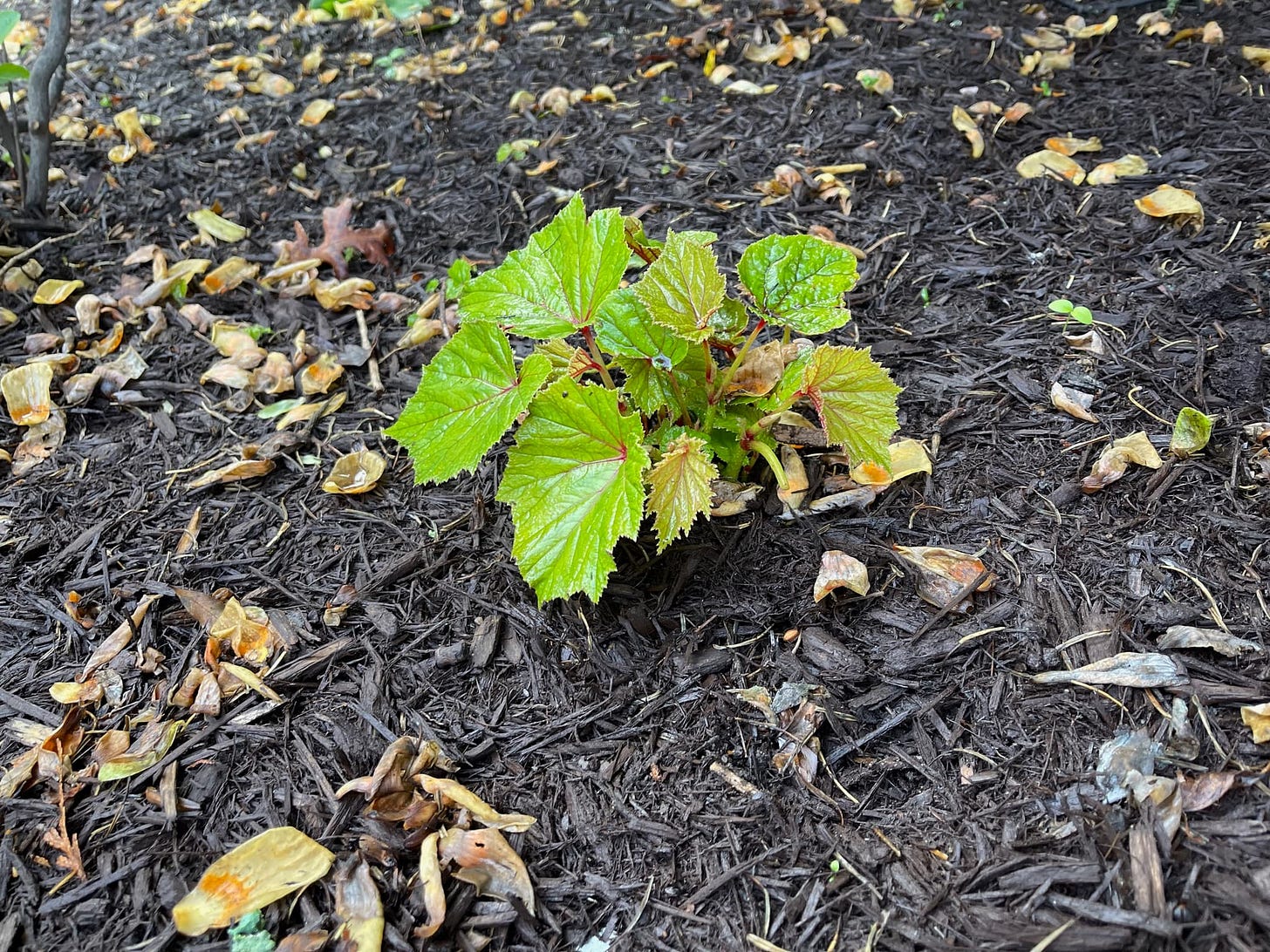
On the other side of the steps bed, we added three Lenten roses to the landscape. The plants were behind the Japanese forest grass that bordered the steps and were meant to add some early spring color to the beds. I’ve always been fascinated by Lenten roses because even though they aren’t roses, (they’re in the buttercup family) their blooms look like roses with blossoms that can be a wide variety of colors. I think many of the cultivars are absolutely beautiful. I didn’t personally plant these, as they were part of the original Sun Nurseries installation, but I’ve been focused on them for three seasons. I lost one of the Lenten roses and had to replace it, but generally my Lenten roses have been a wonderful addition to my early spring garden … except for the one in the middle. For the first two seasons I was fixated on that one plant because it seemed healthy enough, but it just wouldn’t bloom. Imagine my surprise when I took a photo of it last year with my PictureThis app and found out that the plant wasn’t a Lenten rose, but was, instead, something called foxglove. I have absolutely no idea how it got there, since it wasn’t part of the original installation from Sun Nursery. They say I must have somehow replaced the original plant with the foxglove, but I don’t think so. Based on my reading, the most popular species of foxglove are not perennials, but biennials. They bloom in their second year and then die. This is going to be a high maintenance plant with an unpleasant outcome, unless I want to collect the seeds and do that whole thing. I’ll figure out what to do with it later in the season.
This spring I was shocked to see that my foxglove is throwing up three different stems with pretty pink flowers. What a showstopper! The plant and flowers are more than 3 feet tall, and I couldn’t be more surprised, and happy. It’s supposed to bloom in season number two, so the mystery continues. Regardless of its provenance, it is a very pleasant surprise number two.
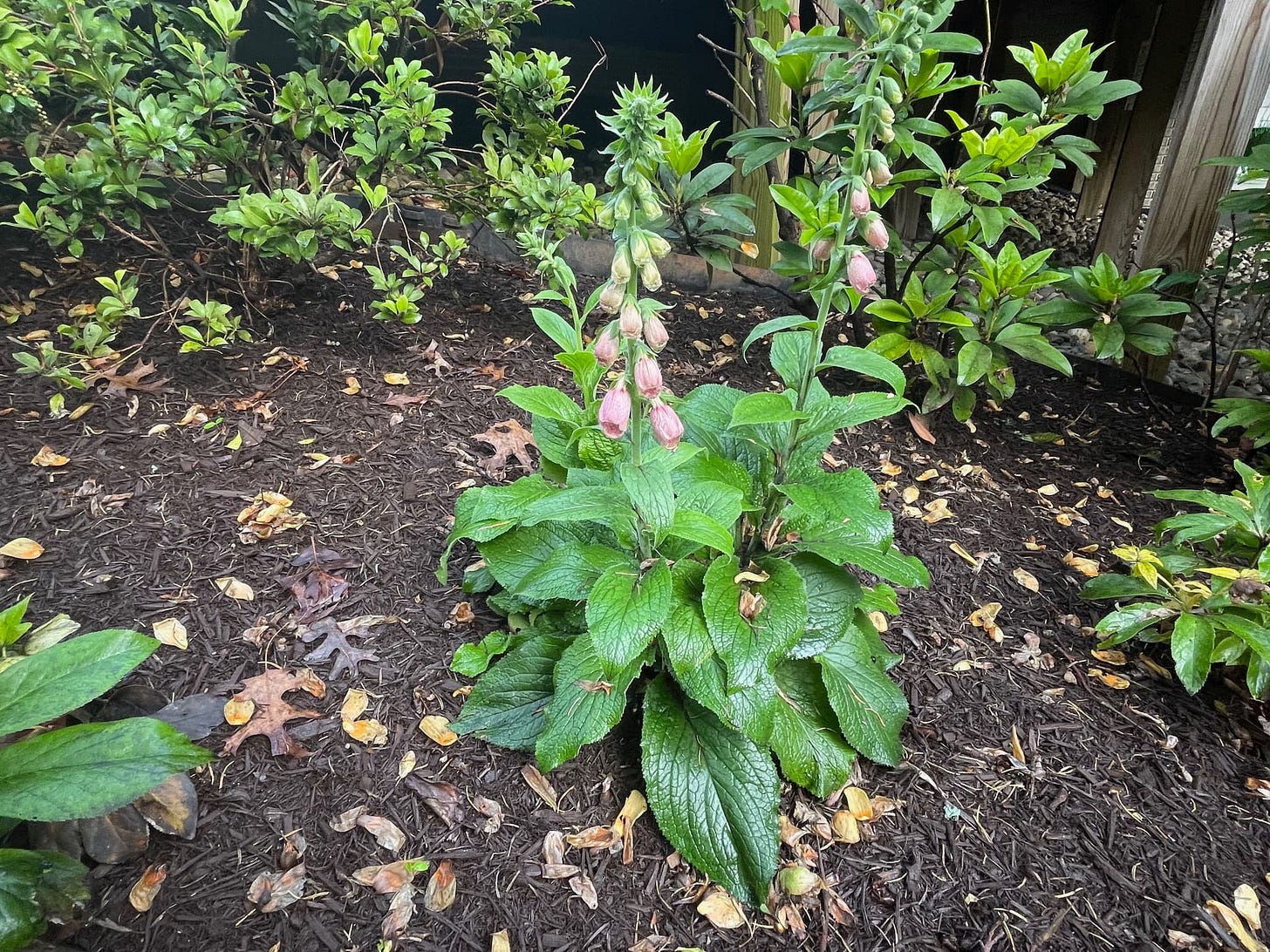
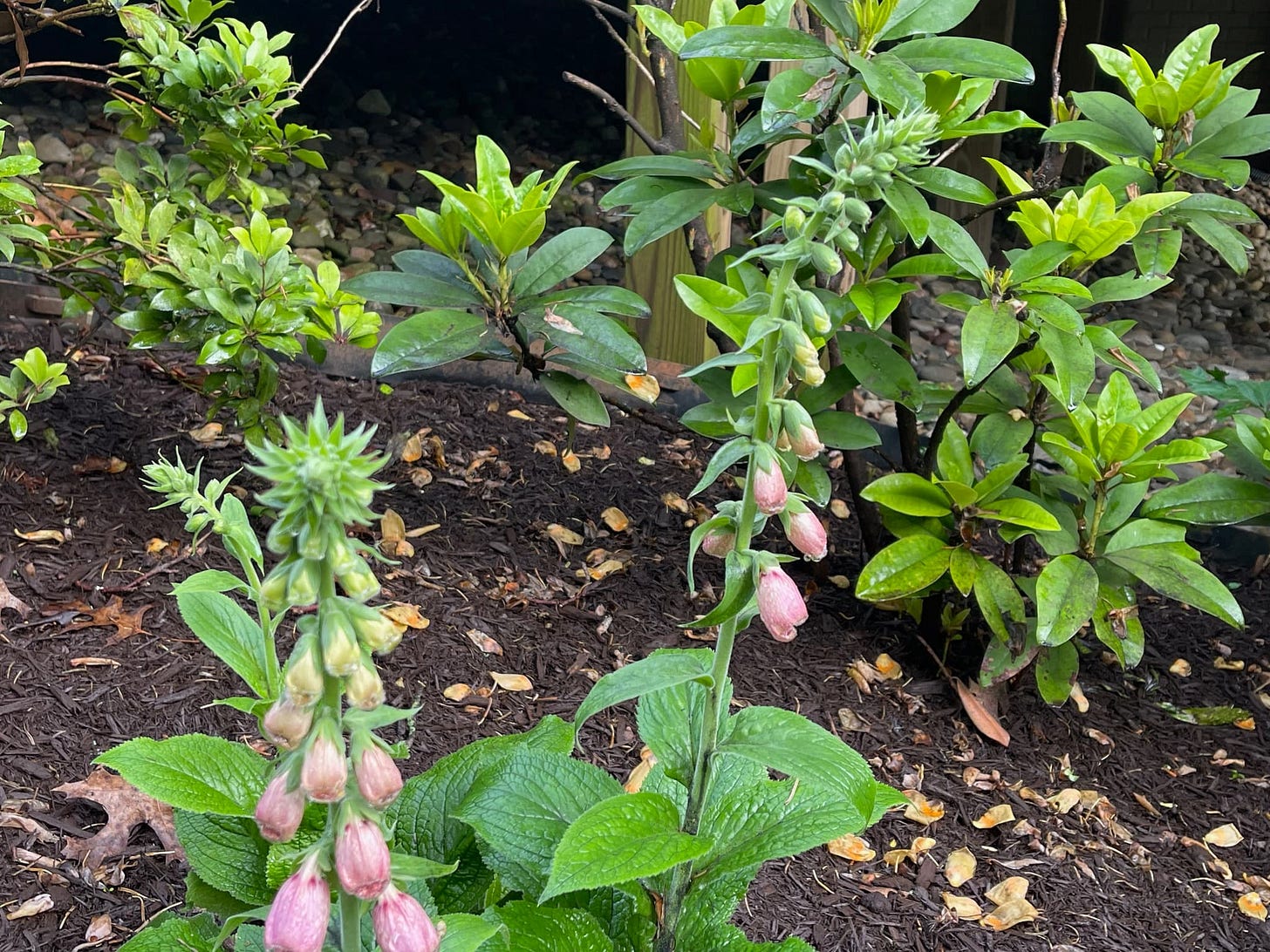
Three years ago, my father-in-law gave us some bulbs and a couple of hydrangea plants. The bulbs had an incredibly long journey from one bed to another until I finally decided I couldn’t use them. Linda kept one hydrangea for her garden at the front of the house. (I have no knowledge of what happened to it.) But the other hydrangea I hijacked for my back garden, where it ended up in the back of my astilbe bed between the elegans hosta and the Japanese anemone (windflower). I should add that my father-in-law’s name among his grandchildren and great grandchildren is “Pop Pop”, so the plant has been known as “Pop Pop’s hydrangea”. It is actually a big leaf hydrangea, but it will be Pop Pop’s hydrangea forevermore as far as I’m concerned. The plant has been flowerless for the three seasons since I added it to my garden.
I have written often in this newsletter that the rules for pruning hydrangea are absolutely incomprehensible. The flowers on the plant grow on the “old wood,” so you shouldn’t trim any of the old wood branches until after the flowers have faded so you don’t lose any of the buds for the following year. You can, apparently, trim branches that are outgrowing their space or just look unsightly, because in that case you don’t care about losing flower buds. When it comes to pruning hydrangea that haven’t flowered, the rules get very cloudy. Some say go ahead and cut back the old wood and others say leave the plant alone. Since I’ve been baffled by this old wood-new wood debate, when it came to this particular plant, I just left it alone. Each season my expectations have dropped since the plant has shown no sign of flowering. My theory was maybe it wasn’t getting enough sun in the back of the bed so close to the house, so I was thinking about moving it to the sun bed, along with all of the other non-blooming plants in the garden, in hopes that more sun would do the trick. What a happy surprise it was to see flower buds on the plant this season. It’s early still, and I don’t know if the buds will actually turn into flowers, but this is definitely a very pleasant surprise number three.
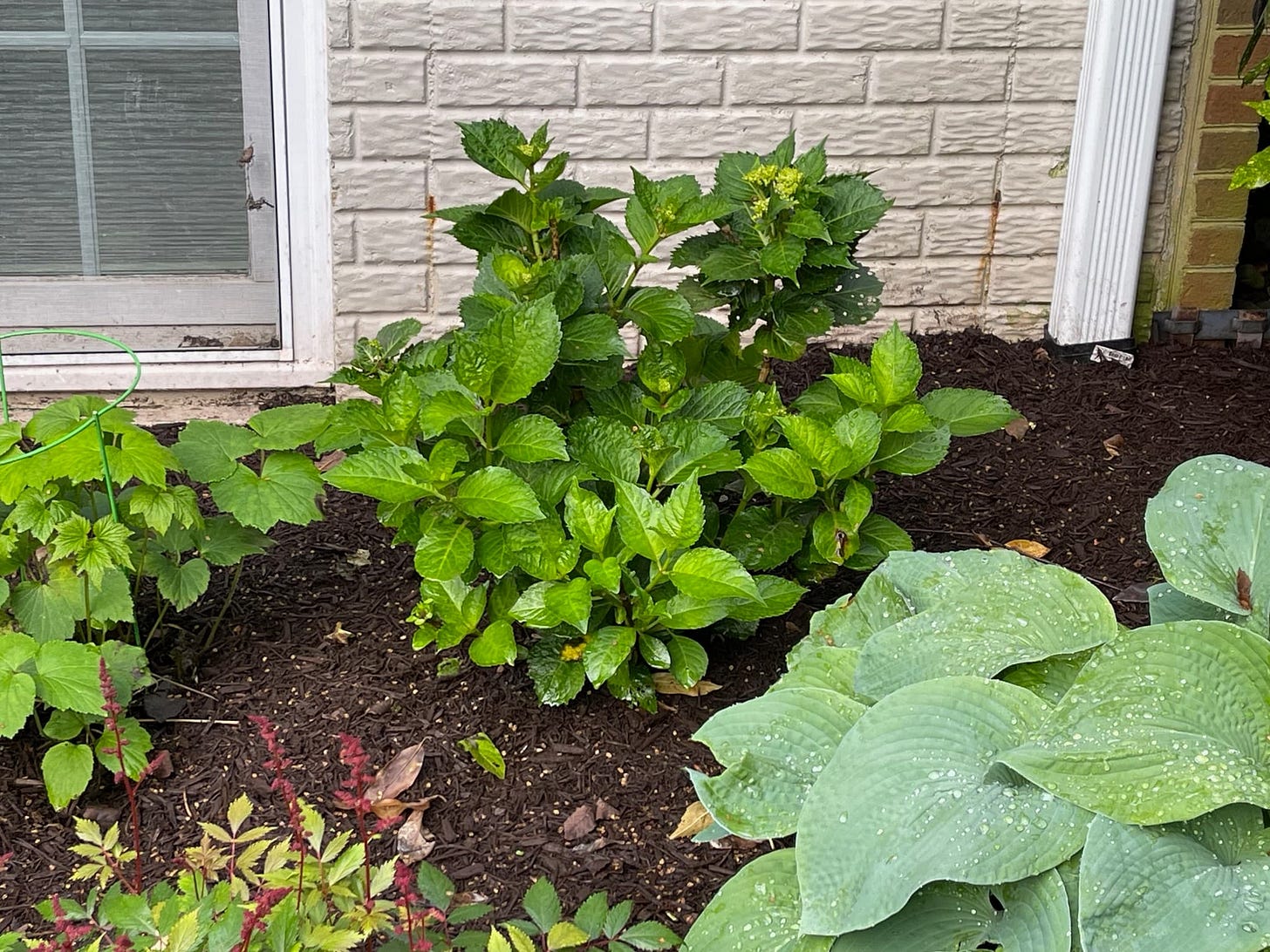
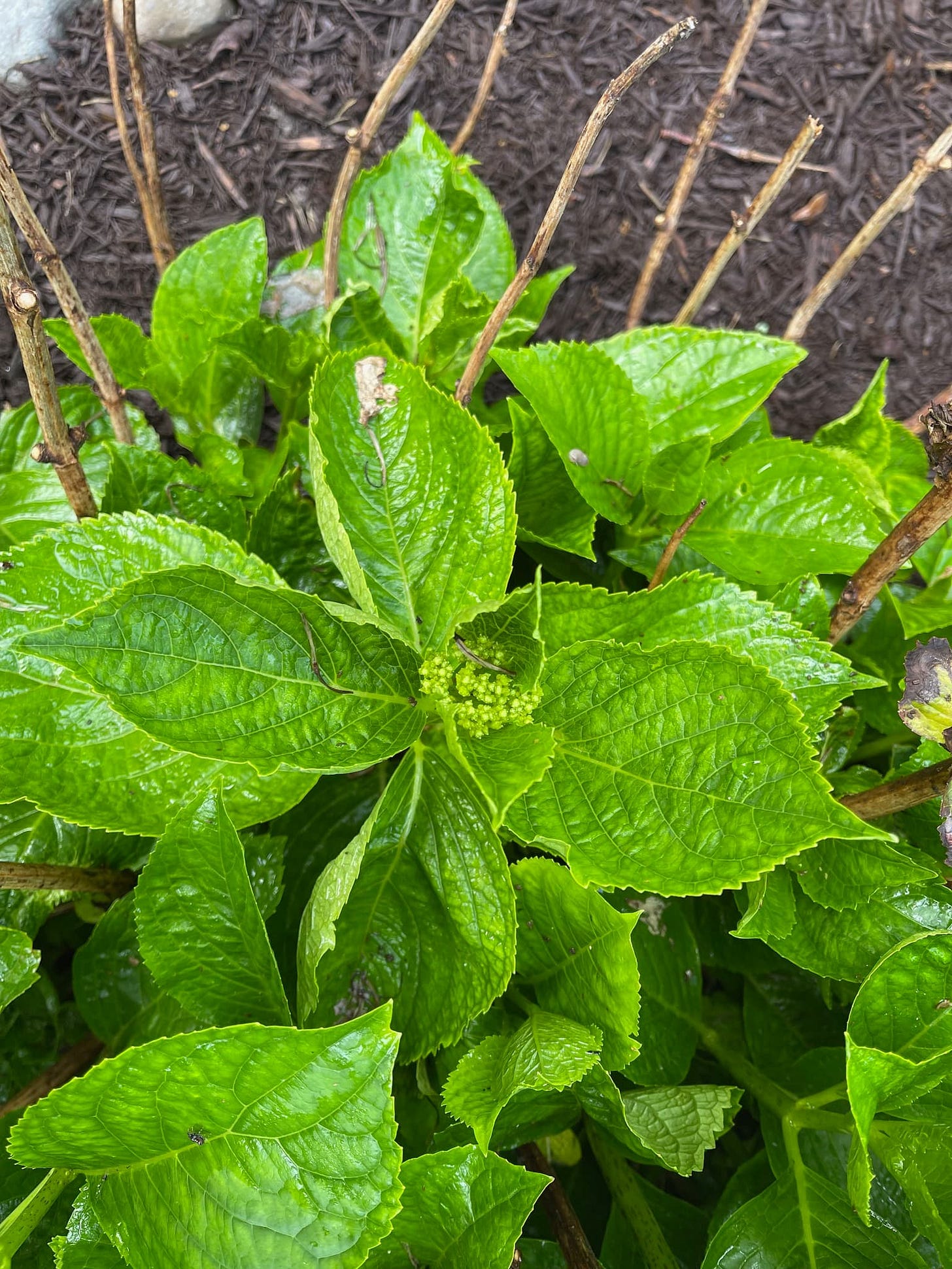
Three very pleasant surprises which should be enough to cheer me up. I’m going out this afternoon to buy some deer and rabbit repellent, stinky stuff that has worked in the past to keep deer out of the garden. What fun! I love the smell of deer repellent in the morning.
I’ve had some bizarre things happen in my garden over the past few seasons. Probably the strangest moment was the morning I came outside to find a huge snapper turtle making a nest in my back bed. Next week I’m going to report on some strange, and creepy, goings on in the garden over the past few weeks. It should make for a fun letter.
As always, if you enjoy the content in this letter, feel free to share it with your network by clicking on the SHARE button. It’s easy. And if you want to check out the other great content from The Painful Education of a Type A Gardener, simply click on the small images of me at the top of the post. You can easily check out the previous posts going back to the beginning of the year.



